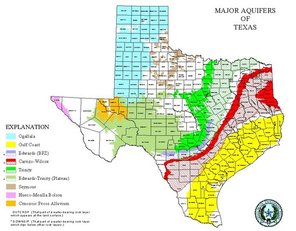South Central Texas is home not only to Austin, the “Hill Country”, and the Alamo, but also for world class springs of the Edwards Aquifer. If you conduct environmental drilling in central Texas, chances are that you drill into or encounter the Edwards Aquifer.
What is the Edwards Aquifer?
A highly productive source of water, the Edwards Aquifer occurs in a crescent-shaped swath through south central Texas, from Edwards and Kinney Counties on the west to Bell County on the east. San Antonio, the seventh largest city in the US, is located in the center of this area.
The Georgetown Formation and the Edwards Group geologic units make up the Edwards Aquifer hydrologic unit. They are fine-grained sediments deposited in one of many geologic periods when central Texas was covered by a shallow sea. When the sea retreated to the southeast, younger layers of sediment deposited on top of the Edwards Aquifer were eroded away and the Edwards Aquifer limestone and marl were exposed to erosion. Later, the shallow sea again moved inland and the Edwards Aquifer was buried by fine-grained sediment layers called a confining unit (Del Rio Clay, Buda Limestone and Eagle Ford Group).
Edwards Aquifer erosion resulted in a network of large pores and cavities created along horizontal and vertical fractures, and sinkholes, connecting the aquifer with the surface. This network of openings and sinkholes allows storage of large volumes of groundwater, quick recharge through the openings and regional flow eastward within the aquifer.
Northwest of the Edwards Aquifer “swath” is the Edwards –Trinity Plateau (the Hill Country) is a catchment for surface water that is funneled into southeast flowing streams. As the streams flow over the Edwards Aquifer, or recharge zone, water infiltrates into the aquifer.
Drilling in the Edwards Aquifer
Millions of people in South Central Texas obtain their water from the Edwards Aquifer. In 1975 the US EPA classified the Edwards Aquifer as a “sole source” aquifer (primary source of drinking water for a geographic area), its first such designation. As a sole source of drinking water, the Edwards Aquifer is an important Texas water resource managed and protected by local water districts.
Soil developed on the exposed Edwards Aquifer, or overlying confining units, will likely be mostly clayey. Push probe or hollow stem auger drilling techniques will be suitable for 50% of the shallow boreholes depending upon whether the soil is rocky.
Rotary drilling, using potable water or air as the drilling fluid, is a suitable drilling technique for the other 50% of the Edwards Aquifer. Drilling requirements, such as borehole casing to the target depth and specifications for borehole diameter and well construction materials, are intended to protect the Edwards Aquifer from contamination or mixing waters with different chemistry.
Who is qualified to drill in the Edwards Aquifer?
Talon/LPE has installed thousands groundwater monitor and recovery wells in the Edwards Aquifer and is knowledgeable of protective drilling requirements. For more information about our environmental drilling services, call 1-866-742-0742.

